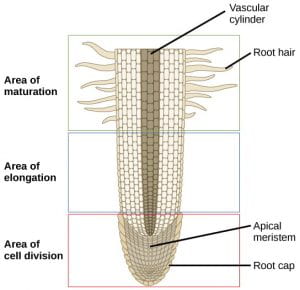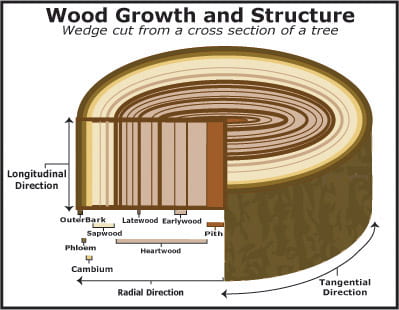If a Flowering Plant Grows in Such a Way That It Primary Axis Continues to Grow and Develop Flower
Learning Objectives
- Differentiate between primary and secondary growth
- Identify and describe the roles of apical vs lateral meristems in plant growth
- Compare and contrast the processes and results of primary vs secondary growth in stems and roots
- Describe the function and organization of woody stems derived from secondary growth
Indeterminate Plant Growth: Meristems
The information below was adapted from OpenStax Biology 30.1
Unlike most animals, who grow to a specific body size and shape and then stop growing (determinate growth), plants exhibit indeterminate growth where the plant will continue adding new organs (leaves, stems, roots) as long as it has access to the necessary resources. Plants are able to continue growing indefinitely like this due to specialized tissues called meristems, which are regions of continuous cell division and growth. Meristematic tissue cells are either undifferentiated or incompletely differentiated, and they continue to produce cells that quickly differentiate, or specialize, and become permanent tissues (dermal, ground, and vascular).
Meristematic tissues consist of three types, based on their location in the plant. Apicalmeristems contain meristematic tissue located at the tips of stems and roots, which enable a plant to extend in length. Lateral meristems facilitate growth in thickness or girth in a maturing plant. Intercalary (also calledbasal) meristems occur only in some monocots, at the bases of leaf blades and at nodes (the areas where leaves attach to a stem). This tissue enables the monocot leaf blade to increase in length from the leaf base; for example, it allows lawn grass leaves to elongate even after repeated grazing or mowing.
Meristems contribute to both primary (taller/longer) and secondary (wider) growth. Primary growth is controlled by root apical meristems or shoot apical meristems, while secondary growth is controlled by the two lateral meristems, called the vascular cambium and the cork cambium. Not all plants exhibit secondary growth.
The video below provides a nice discussion of primary and secondary growth in plants (beginning at 2:20):
Primary growth in roots
The information below was adapted from OpenStax Biology 30.3
Root growth begins with seed germination. When the plant embryo emerges from the seed, the radicle of the embryo forms the root system. The tip of the root is protected by the root cap, a structure exclusive to roots and unlike any other plant structure. The root cap is continuously replaced because it gets damaged easily as the root pushes through soil. Behind the root cap, within the first centimeter or so, the root tip can be divided into three zones:
- The zone of cellular division, which contains the apical meristem, is the location immediately behind the root cap where cells are actively dividing via mitosis.
- The zone of cellular elongation is the location where the newly formed cells are growing, or increasing in length, to add length to the root. This process requires uptake of water, which literally stretches the cells and increases their size.
- The zone of cellular maturation is the location where newly elongated cells complete their differentiation into the dermal, vascular, or ground tissues. Maturation is driven by changes in gene expression.

The root tip is divided into three areas: an upper area of maturation, a middle area of elongation, and a lower area of cell division at the root tip. In the area of maturation, root hairs extend from the main root and cells are large and rectangular. The area of elongation has no root hairs, and the cells are still rectangular, but somewhat smaller. A vascular cylinder runs through the center of the root in the area of maturation and the area of elongation. In the area of cell division the cells are much smaller. Cells within this area are called the apical meristem. A layer of cells called the root cap surrounds the apical meristem. Image credit: OpenStax Biology
Plants may also havelateral roots that branch from the main tap root. The lateral roots originate from meristematic tissue in thepericycle, which is the outermost cell layer in the vascular cylinder in the center of the root (shown below). Once they have emerged, lateral roots then display their own primary growth, continually adding length to the lateral root.

Staining reveals different cell types in this light micrograph of a wheat (Triticum) root cross section. Sclerenchyma cells of the exodermis and xylem cells stain red, and phloem cells stain blue. Other cell types stain black. The stele, or vascular tissue, is the area inside endodermis (indicated by a green ring). Root hairs are visible outside the epidermis. (credit: OpenStax Biology, scale-bar data from Matt Russell)

The image is of a transverse section of part of a root of the monocot Maize (Zea mays) showing the stele and a lateral root. Lateral roots develop from a layer of cells underneath the endodermis, called the pericycle. They originate by cell division of pericycle cells opposite a protoxylem group. The root starts to swell as the new lateral root penetrates outwards towards the surface, pushing its way through cortical parenchyma cells and finally bursting out through the epidermis into the soil. As it grows it develops xylem and phloem, which become connected with the vascular tissues of the main root. This process is very different from that which takes place in shoots, where lateral branches forming stems or leaves originate only from the apical meristematic tissue of the shoot. Lateral roots can develop large distances away from the root tip. Image by John Bebbington FRPS, https://www.flickr.com/photos/71183136@N08/6947183226
Primary growth in shoots
The information below was adapted from OpenStax Biology 30.2
Just as in roots, primary growth in stems is a result of rapidly dividing cells in the apical meristems at the shoot tip. Subsequent cell elongation then leads to primary growth.
In many plants, most primary growth occurs primarily at the apical (top) bud, rather than axillary buds (buds at locations of side branching). The influence of the apical bud on overall plant growth is known as apical dominance, which prevents the growth of axillary buds that form along the sides of branches and stems. Most coniferous trees exhibit strong apical dominance, thus producing the typical conical Christmas tree shape. If the apical bud is removed, then the axillary buds will start forming lateral branches. Gardeners make use of this fact when they prune plants by cutting off the tops of branches, thus encouraging the axillary buds to grow out, giving the plant a bushy shape.
Secondary growth in shoots (and roots)
The process of secondary growth is controlled by the lateral meristems, and is similar in both stems and roots. Lateral meristems include the vascular cambium and, in woody plants, the cork cambium (cambium is another term for meristem). Herbaceous (non-woody) plants mostly undergo primary growth, with hardly any secondary growth or increase in thickness. Secondary growth, or wood, is noticeable in woody plants; it occurs in some dicots, but occurs very rarely in monocots.
The details below are specific to secondary growth in stems. While the principles are similar for secondary growth in roots, the details are somewhat different. We will discuss only the details specific to stems.
The vascular cambium is located between the primary xylem and primary phloem within the vascular bundle. (Recall that xylem is located toward the interior and phloem toward the exterior of the bundle.) The cells of the vascular cambium divide and form secondary xylem (tracheids and vessel elements) to the inside, and secondary phloem (sieve elements and companion cells) to the outside. The cells of the secondary xylem contain lignin, the primary component of wood, which provides hardiness and strength. The xylem together with the pith form thewood of a woody stem.
In woody plants, cork cambium is the outermost lateral meristem. It produces cork cells, which contain a waxy substance that can repel water. The phloem together with the cork cells form the bark, which protects the plant against physical damage and helps reduce water loss. The cork cambium also produces a layer of cells known as phelloderm, which grows inward from the cambium. The cork cambium, cork cells, and phelloderm are collectively termed the periderm. The periderm substitutes for the epidermis in mature plants.
The combined actions of the vascular and cork cambia together result in secondary growth, or widening of the plant stem. These structures are illustrated below:

In woody plants, primary growth is followed by secondary growth, which allows the plant stem to increase in thickness or girth. Secondary vascular tissue is added as the plant grows, as well as a cork layer. The bark of a tree extends from the vascular cambium to the epidermis. Image credit: OpenStax Biology
A new layer of xylem and phloem are added each year during the growing season. The interior xylem layers eventually die and fill with resin, functioning only in structural support. The interior, nonfunctional xylem is called heartwood. The newer, functional xylem is calledsapwood. The exterior layers of phloem eventually become crushed against the cork cambium and are broken down. Thus a mature tree contains many interior layers of older, nonfunctional xylem deep within the stem, but only a small amount of older phloem.

The layers of tissues within a mature tree trunk. Image based on work by Brer Lappin – Public Domain, https://commons.wikimedia.org/w/index.php?curid=8979988
This video describes the process and result of secondary growth in stems:
Secondary Growth and Annual Rings
The activity of the vascular cambium results in annual growth rings. During the spring growing season, cells of the secondary xylem have a large internal diameter and their primary cell walls are not extensively thickened. This is known as early wood, or spring wood. During the fall season, the secondary xylem develops thickened cell walls, forming late wood, or autumn wood, which is denser than early wood. This alternation of early and late wood is due largely to a seasonal decrease in the number of vessel elements and a seasonal increase in the number of tracheids. It results in the formation of an annual ring, which can be seen as a circular ring in the cross section of the stem (shown below). An examination of the number of annual rings and their nature (such as their size and cell wall thickness) can reveal the age of the tree and the prevailing climatic conditions during each season.

The rate of wood growth increases in summer and decreases in winter, producing a characteristic ring for each year of growth. Seasonal changes in weather patterns can also affect the growth rate, causing the rings vary in thickness. CC BY 2.5, https://en.wikipedia.org/w/index.php?curid=11591972
Source: https://organismalbio.biosci.gatech.edu/growth-and-reproduction/plant-development-ii-primary-and-secondary-growth/